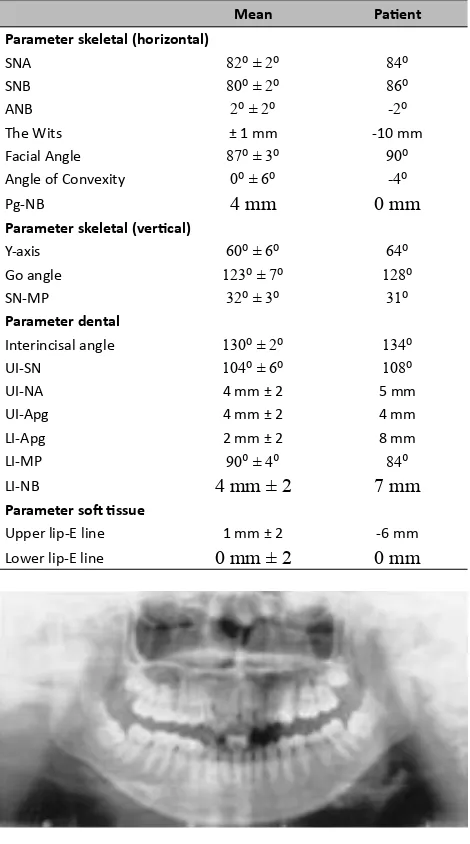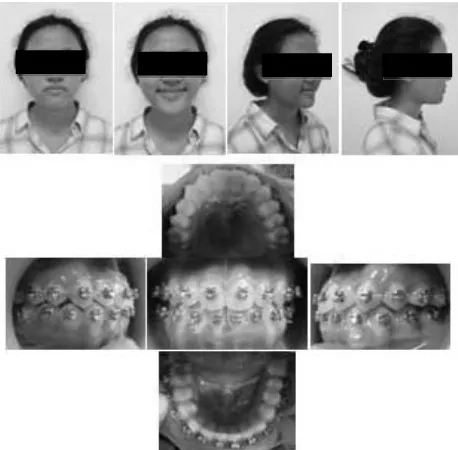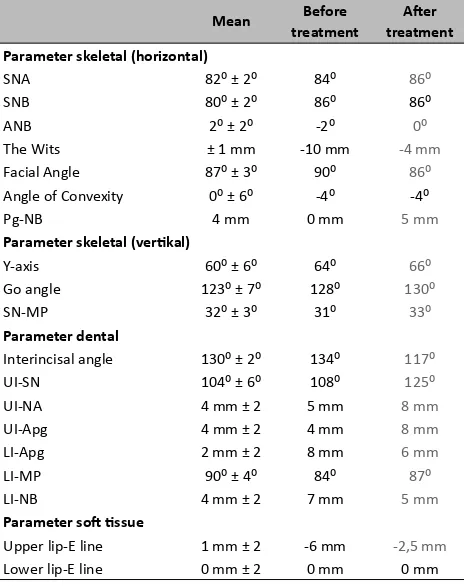Camou
fl
age orthodontic treatment in skeletal class
III malocclusion with passive self-ligating system
Diah Adisty and KrisnawaƟ
Department of Orthodon cs
Faculty of Den stry, Universitas Indonesia Jakarta - Indonesia
Correspondence: Diah Adisty, c/o: Departemen Ortodonsia, Fakultas Kedokteran Gigi Universitas Indonesia. Jl. Salemba Raya 4 Jakarta 10430, Indonesia. E-mail: drg_adisty@yahoo.com
ABSTRACT
Background: Skeletal Class III malocclusion treatment is a diffi cult case because jaw discrepancies are severe sometimes. However, in the case of skeletal Class III malocclusion small to moderate level with functional shift where the incisor teeth position can reach edge to edge relationship in centric relation, then the prognosis will be bett er. In this case report, treatment of skeletal Class III malocclusion with functional shift s can be done with orthodontic camoufl age, which is intended to fi xed malocclusion, eliminating factors that cause/interfere and create a good interdigitation when the mandible is in centric relation. Purpose: To perform camoufl age orthodontic treatment in skeletal class III malocclusion in order to create a relationship of good dental occlusion. Case: Female patients, aged 17 years and 9 months old, came to the orthodontic clinic at RSGMP FKGUI with chief complaints of her upper front teeth position more to the back of the lower front teeth. Clinical examination came with a result of negative overjet, severe crowding in the upper jaw, asymmetry, concave profi le, deviation when jaw closed, and centric occlusion is not the same with centric relation. Case management: Treatment of skeletal Class III malocclusion is done with camoufl age treatment using the self-ligating system through the anterior teeth of the upper jaw protraction. The selection of self-ligating system was based on the various advantages, which include low friction between the bracket with archwire, an additional signifi cant and stable width in intermolar and interpremolar, and the presence of a lip bumper eff ect. During 15 months of treatment, the result of overjet becomes positive, teeth are at the arched, asymmetry was corrected, fl at profi le, and there is no deviation when jaw closed.
Conclusion: In the case of mild and moderate class III malocclusion, orthodontic camoufl age is oft en selected, with or without extraction (proclination of upper incisor and retroclination of lower incisor were recured). That condition may cause an unstable treatment results. Therefore, the use of self-ligating brackets will become an appropriate option to reduce fl aring eff ects of upper incisor teeth by the lateral expansion of the posterior region.
Keywords: Camoufl age treatment; skeletal class III malocclusion; passive self ligating
ABSTRAK
III skeletal ini dilakukan dengan perawatan kamufl ase menggunakan sistem self-ligating melalui protraksi gigi-gigi anterior rahang atas. Pemilihan sistem self-ligating dilakukan berdasarkan pertimbangan berbagai kelebihan pada sistem ini, antara lain friksi yang rendah antara braket dengan archwire, adanya penambahan lebar interpremolar dan intermolar yang signifi kan serta stabil, dan adanya lip bumper eff ect. Dalam 15 bulan perawatan overjet menjadi positif, gigi-gigi berada pada lengkungnya, asimetri terkoreksi, profi l datar, dan tidak terdapat deviasi saat penutupan rahang. Simpulan: Pada kasus maloklusi skeletal kelas III ringan dan sedang, perawatan ortodonti kamufl ase dapat dilakukan, dengan atau tanpa ekstraksi (proklinasi dari gigi insisif atas dan retroklinasi dari gigi insisif bawah). Kondisi ini dapat menyebabkan hasil perawatan yang tidak stabil. Oleh karena itu, penggunaan braket self ligating akan menjadi pilihan yang tepat untuk mengurangi efek proklinasi gigi insisif atas dengan ekspansi lateral regio posterior.
Kata kunci: Perawatan kamufl ase; maloklusi kelas III skeletal; passive self ligating (Damon Q)
INTRODUCTION
Dental aspect of Class III malocclusion is characterized by the mesiobuccal cusp of the upper fi rst molar occludes with the mesiobuccal groove
of the lower fi rst molar.1 From skeletal aspect, class III malocclusion oft en due to abnormal growth of the mandible (excessive bone growth), less optimal maxillary bone growth, or a combination of both. Class III malocclusion prevalence varies depending on the type of race. Mongoloid race has the greatest prevalence in the amount of 12%.1
Skeletal Class III malocclusion is a case in which the treatment of malocclusion is diffi cult because jaw discrepancies are oft en severe. There is bett er prognosis in mild to moderate cases of skeletal Class III malocclusion with the functional shift position where the incisor teeth can reach edge to edge relationship. Treatment of skeletal Class III malocclusion cases in the presence of functional shift s can be performed by orthodontic camoufl age, which is intended to correct malocclusion, eliminating the interference factors and creating a good interdigitation when the mandible is in centric relation.
Self-ligating system in orthodontic treatment uses a bracket fi xed to the ligation mechanism in it, so it can be opened and closed to lock the wire in the slot without the need for wires or elastomeric ligation. This system is also provide include a low friction between the bracket to the archwire, intermolar and interpremolar additional width that more signifi cant and stable, and the presence of a lip bumper eff ect.3
This case report will discuss the treatment of Class III malocclusions in the presence of functional shift s in female patients aged 17 years and 9 months using passive self-ligation system (Damon Q). Treatment was intended to eliminate premature
contacts between the upper and lower incisor teeth, and the profi le and occlusion improvements will be achieved.
CASE
Female patient, student of Faculty of Medicine, University of Indonesia, aged 17 years 9 months, came to the clinic RSGMP FKGUI with chief complaints of upper front teeth are located backward from the lower front teeth (Figure 1).
Extra-oral clinical examination showed that patient had mesofacial face, asymmetric and concave soft tissue profi le. Intra-oral clinical examination showed that oral hygiene and gingiva was moderate, there was no tooth mobility, palate and tongue was moderate (Figure 1).
All the permanent teeth have erupted perfectly, except the unerupted third molars. Left fi rst molar have missing and replaced with supernumerary teeth. There was no persistency of decidious teeth. Right fi rst molar relationship were Class III. Both canine relationships are class III. Overjet was -3 mm, whereas overbite was 4 mm. There were deep compensation curve in the upper jaw and lower jaw, normal curve of Spee, normal midline upper teeth and lower teeth shift to the left 2 mm. The shape of the upper and lower dental arches were oval (Figure 1).
On functional examination, there were no abnormalities of the temporomandibular joint. There was a deviation to the left in the opening and closing of the mandible. There was a vertical interference in the anterior region (11, 21 to 41, 31). There was also normal patt ern of swallowing and speech. Patients did not have bad habits. On examination showed that Centre Occlusion was not the same as the Centre Relation.
From the results of cephalometric analysis (Table 1), it can be concluded that there were class III jaw relationship with the normal maxillary and mandibular prognatic, concave skeletal profile, normal mandibular growth direction, normal vertical growth of the middle and lower face, upper incisor inclination towards the lower incisor was retrusive, upper incisor inclination to the cranial base was protrusive , the lower incisor inclination of the mandibular plane was retrusive, upper lip was retrusive with normal lower lip (Figure 2 and Table 1).
Table 1. Cephalometric analysis
Mean PaƟ ent
Parameter skeletal (horizontal)
SNA 82⁰ ± 2⁰ 84⁰
SNB 80⁰ ± 2⁰ 86⁰
ANB 2⁰ ± 2⁰ -2⁰
The Wits ± 1 mm -10 mm
Facial Angle 87⁰ ± 3⁰ 90⁰
Angle of Convexity 0⁰ ± 6⁰ -4⁰
Pg-NB 4 mm 0 mm
Parameter skeletal (verƟ cal)
Y-axis 60⁰ ± 6⁰ 64⁰
Go angle 123⁰ ± 7⁰ 128⁰
SN-MP 32⁰ ± 3⁰ 31⁰
Parameter dental
Interincisal angle 130⁰ ± 2⁰ 134⁰
UI-SN 104⁰ ± 6⁰ 108⁰
UI-NA 4 mm ± 2 5 mm
UI-Apg 4 mm ± 2 4 mm
LI-Apg 2 mm ± 2 8 mm
LI-MP 90⁰ ± 4⁰ 84⁰
LI-NB 4 mm ± 2 7 mm
Parameter soŌ Ɵ ssue
Upper lip-E line 1 mm ± 2 -6 mm Lower lip-E line 0 mm ± 2 0 mm
Figure 3. Panoramic radiograph.
Panoramic radiograph showed that 18 and 28 tooth germs both in vertical position, 38 and 48 are in a mesioangular position. There is a supernumerary teeth in mandibular left posterior. Alveolar bone height is normal, as well as the absence of abnormalities in the maxillary sinus, but less roots parallel alignment (Figure 3).
Lundstrum analysis indicated a lack of space in the upper jaw of 10 mm and the lower jaw of 2.5 mm. Meanwhile, Bolton’s analysis showed that the ratio of anterior teeth with the mesiodistal width of the mandibular was excess of 3.11 mm compared to the upper jaw.
Kesling analysis was calculated by maintaining the position of the lower dental arch, to advance 4 mm maxillary forwarding, 2 mm shift ing lower dentition midline to the right. The needs of the space in the upper jaw was 0 mm and the lower jaw was -2 mm (right -1,5 mm, left -0.5 mm).
Skeletal factors that play a role in this case is in the direction of anteroposterior jaw relationship which is class III malocclusion with mandibular prognati, and in the transverse directions are crossbite posterior. Dental factors is the discrepancy of dental arch and teeth, thus causing crowding in the maxilla and mandible. There is a vertical interference in the anterior region, causing mandible located more anteriorly in centric occlusion.
Female patient, student of Faculty of Medicine, University of Indonesia, aged 17 years 9 months, with mesofacial face type, asymmetric and concave soft tissue profi le. Class III jaw relationship with normal maxillary and mandibular prognati, concave skeletal profi le, normal mandibular growth direction, normal vertical growth of the middle and lower face, upper incisor inclination towards the bott om is retrusive, upper incisor inclination towards cranial base is normal, the lower incisor inclination of the mandibular plane is retrusive , upper lip retrusive and lower lip normal .Right fi rst molar relationship is Class III. Canine relationships are class III. Overjet of -3 mm, whereas overbite of 4 mm. Deep compensation curve in the upper jaw. The lower dentition midline shift to the left 2 mm. The need for space in the upper jaw and the lower jaw of 0 mm at -2 mm (right -1.5 mm, -0.5 mm left ).
CASE MANAGEMENT
On functional examination showed that CO and CR in these patients is not the same. CR examination showed the upper and lower incisor relationship edge to edge with overjet of 0 mm, so the camoufl age procedure will be chosen for treatment. Taking into account the advantages contained in the self-ligating bracket, it was decided to use a passive self ligating system (Damon Q). Standard torque bracket prescription is used both in the maxilla and mandible. Camoufl age procedures performed by protraction and intrusion of the maxillary anterior region by considering the inclination of the maxillary incisor.
Scaling was started before bonding bracket. Bracket att ached to the upper jaw fi rst. Bonding bracket on the lower jaw is planned to be carried out if the relationship is already jumping the bite. In this case also planned the use of early elastic since the early stages of treatment. Finishing is done to obtain a good interdigitation. Then the retention phase is done by essix retainer on the upper and lower jaw.
After 15 months of treatment is 7 times the control visit, the outcome is negative overjet correction (anterior crossbite) from -3 mm to +2 mm, deep overbite of +4 mm to +2 mm, severe crowding correction in the upper jaw and light on mandible, midline shift correction, canine and molar relationship from class III into class I (Figure 4).
Figure 4. Photo of extraoral and intraoral patients after 15 months of treatment.
Table 2. Cephalometric Analysis a er 15 months of treatment
Parameter skeletal (verƟ kal)
Y-axis 60⁰ ± 6⁰ 64⁰ 66⁰
Figure 6. Superimposi on cephalometric photo on SN fi eld.
Note: The black color shows the pre-treatment cephalometric. The red color shows the cephalometric aft er 15 months of treatment.
Cephalometric superimposition picture before and aft er 15 months treatment shows that there are change in dental, which is a signifi cant maxillary incisor proclination to obtain a normal overjet. Also the presence of mandibular rotation in a clockwise direction. Then the molar relationship of class III into class I. Good soft tissue profi le (Fgure 6 and Figure 7).
Figure 7. Profi le photos of pa ents before and a er 15 months
of treatment.
DISCUSSION
Camoufl age procedurs was chosen because the functional analysis showed that CO and CR in these patients is diff erent. CR examination showed that the upper and lower incisor relationship edge to edge with overjet of 0 mm. Since there is several advantages in the self-ligating bracket system, it was decided to use a passive self ligating system (Damon Q). Standart bracket prescription was used on both upper and lower jaw, due to the initial incisor position and edge to edge incisor relationship while centric relation. Camouflage procedures were performed by protraction and intrusion of the maxillary anterior region by considering the inclination of the maxillary incisors.
Treatment was preceded by bonding bracket on the upper jaw. It is intended to obtain positive overjet by proclination of incisor teeth of the maxilla. Posterior bite riser was made to free the anterior bite, so the upper incisor can easily move forward. Mandibular bracket were bonded when positive overjet had been achieved. Early elastic mechanism which is one of the advantages of self-ligating system was applied, using the class III elastic from 16-43 and 26-33. This procedure was done to get the canine and molar relationships into class I from the beginning of treatment.
be done with labial root torque by using the third order bend. Proclination incisor did not change the patient’s upper lip, probably because in the initial condition the upper right incisor tip position was at the lower incisor tip position, and the upper lip was rests on the lower lip in the initial conditions. Canine and molar relationship were changed from class III into class I. This might be due to the early use of Class III elastic at initial treatment.
Presence of mandibular rotation in a clockwise direction make an elevation in the lower third of the face. This likely occurred because there was no interference aft er the upper incisor teeth had been protracted.
The conclusion of this case report was that class III malocclusion is a diff erent case due to severe jaw discrepancies. However, the prognosis is bett er in the mild to moderate Class III malocclusion cases with incisor tooth position can reach edge to edge relationship. Therefore in the case of mild and moderate class III malocclusion, orthodontic camouflage is often selected, with or without extraction.
In the camouflage treatment of Class III malocclusion without extraction, usually proclination of upper incisor and retroclination of lower incisor were recured. That condition may cause an unstable treatment results. Therefore, the use of self-ligating brackets will become an appropriate option to reduce fl aring eff ects of upper incisor teeth by the lateral expansion of the posterior region. Damon System also has the advantages of early torque control and a variety of mechanisms that can be done since the beginning of treatment to correct the incisor inclination and to obtain good occlusion aft er the interference factor is eliminated with the use of early elastic and the control time interval is longer than usual.
REFERENCES
1. Mitchell L. An introduction to orthodontics. 3rd ed. New
York: Oxford University Press Inc; 2007. p. 6-8, 140-145. 2. Dawson PE. Functional occlusion from TMJ to smile
design. 1st ed. St. Louis: Elsevier; 2007. p. 17-44.
3. Eliades T, Pandis N. Self-ligation in orthodontics. 1st ed.
Oxford: Blackwell Publishing Ltd; 2009. p. 19-44. 4. Nanda R. Biomechanics and esthetic strategies in clinical
orthodontics. St. Louis: Elsevier; 2005.
5. Chen F, Wu L, Terada K, Saito I. Longit udinal intermaxillary relationships in class III malocclusions with low and high mandibular plane angles. Angle Orthod 2007; 77(3): 397-403.
6. Sugawara J. Clinical practice guidelines for developing class III malocclusion. In: Nanda R, editor. Biomechanics and esthetic strategies in clinical orthodontics. St. Louis: Elsevier; 2005. p. 211-2.
7. Proffit WR, Fields HW, Sarver DM. Contemporary orthodontics. 4th ed. 2007. St Louis: Elsevier; 2007. 8. Chen SS, Greenlee GM, Kim JE, Smith CL, Huang GJ.
Systematic review of self-ligating brackets. Am J Orthod Dentofacial Orthop 2010; 137(6): 726.e1-726.e18.
9. Harradine N. The history and development of self-ligating brackets. Semin Orthod 2008; 14: 5-18.
10. Graber TM, Vanarsdall RL, Vig KWL. Orthodontics: Current principles and techniques. St. Louis: Mosby; 2005. p. 753-831.
11. Birnie D. The Damon passive self-ligating appliance system. Semin Orthod 2008; 14: 19-35.
12. Baek S, Kim K, Hwang S. New trend in orthodontics-basic priciples, biomechanics, and clinical application of Damon system. Korea: Shinhung International Inc; 2007. p. 89-118.
13. Harradine N. Self-ligating bracket : theory, practice and evidence. In : Graber LW, Vanarsdall RL, Vig WL, eds. Orthodontic current principles and technique. 5th ed. St.



